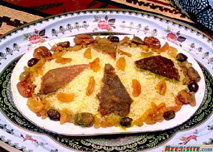|
More tips on countries I visited lavesine.tripod.com/travel/
More info from all around the planet: Lonelyplanet.com
Azerbaijan, Kyrgyzstan, and Kazakhstan

Nowrooz: Ancient Holiday Lives at AUBG
by Yekaterina Chzhen AUBG students from Azerbaijan, Kyrgyzstan, and Kazakhstan celebrate their traditional New Year every year
on March 21. The name of the holiday has many spellings - Novruz, Nowrooz, Nowruz, Noruz and No Ruz. It means a new day in
Farsi. The holiday symbolizes the revival of nature in Zoroastrian system, and coincides with the spring equinox. Its origins
hark back even further in the past - back to about 3000 BC in the ancient Mesopotamia. Nowrooz survived the dominance of Islam
and the Soviet suppression. Today, it is an official New Year in Iran and has a strong tradition in Central Asia, Azerbaijan,
Afghanistan and parts of Turkey. AUBGers celebrate it differently in their respective countries. Jamal Hasanov,
junior from Azerbaijan: To me personally this is the best holiday! People usually cook a lot of sweets, everyone is
very joyful. There are all kinds of activities bringing a lot of people together, such as bonfire. A thing called Khoncha
is necessary in every family. It`s a tray full of different kinds of nuts, dry fruit, peculiar Novruz sweets, boiled and painted
eggs. You need Semeni too. That is sprung wheat symbolizing blossoming and awakening of nature. Our family gathers
at one table, the Khoncha in the middle of it. Semeni is on the table all the time. We lit candles - that is
crucial, since the whole holiday is all about fire. We always go downstairs and make a bonfire. Then we jump over it. It also
symbolizes something, but I don`t remember what. Azizbek Bakiev, senior from Kyrgyzstan: On the eve of
Nooruz [March 20] we dig a big hole in the ground, place a cauldron and cook Sumalyak, a sweet meal of wheat, walnuts
and some other ingredients. We stir it the whole night, make wishes for the coming year, and then cover the cauldron. On the
next day, every community gathers at common table, opens the cauldron, and a moldo [Islamic priest] gives a prayer.
Nooruz is an organized national holiday as important as the New Year of Dec. 31. We have musicians in the streets and yurts
[traditional houses] with food. We also have horse races and other traditional competitions, like the bowl of song. Every
participant drinks from the bowl, sings a song, and passes the bowl to another singer. Zarina Bakenova, sophomore
from Kazakstan: Unlike in Azerbaijan, we celebrate Nauriz on March 22. The traditional meal is Nauriz-kozhe
made of seven components, including wheat and horse milk. It is a weird dish, but it actually tastes good. It is given for
free in yurts in the streets along with traditional Kazakh food like meat and baursaki [national pastry]. Nauriz
is a day off and every city makes an organized celebration. We have famous traditional singers singing in concert halls in
our city. There are also singers and musicians playing in the streets. Nauriz is a newly accepted holiday. It was not celebrated
openly during the Soviet time. Now, it is almost as important as the common New Year, but we dont usually give presents. We
have family dinners and greet everybody. Eldar Agayev, senior from Azerbaijan: We are making a holiday
dinner on March 21, but we are not cooking the specific Novruz food this time. To have the sprung wheat, Khoncha, you
need to plant the seeds at least a week in advance. Usually, the preparation for the holiday starts four weeks earlier and
people do major cleanings of their houses, gardens and other every Wednesday. They prepare seven traditional dishes for Novruz,
one of them is plov [fried rice, meat, vegetables]. Then people play games and jump over bonfires. Children do something
like the American Trick-o-Treating - they leave their hats in front of every door, and later get them back filled with sweets.
The holiday is as important for the Azeri people as the two major Muslim holidays, Kurban Bayramy and Ramazan Bayramy. The
celebration of the Muslim holidays was suppressed during the Soviet rule, but the non-Muslim Novruz was not suppressed to
the same extent. Maybe thats why the tradition stayed so strong.
FlashNews Weekly March
21 28, 2002
Join Flash-news readers here
Read more about Persian New year here.
BULGARIA
General info about Bulgaria, click here

Baba Marta : 1st of March
March, the only month with feminine ending in Bulgarian. Nobody knows what is the origin of the feminine form of March;
people say that it came as a result of the changeable March weather. "As fickle as the Marta weather" is common saying
often used in Bulgarian. On the first day of March, we are celebrating Baba Marta (grandma Martha) which is
closely connected with this month. People give each other MARTENITSAS: twisted red and white threads in the past nowadays
they are more elaborate and look like small souvenirs. People wear martenitsas until they see a stork, i.e. when winter is
over. You can buy them at bookstores, stationar's, souvenir shops, on the street, almost everywhere. MARTENITSA is the symbol
of health, happiness and success throughout forthcoming spring.
Read more about it
or here
ROUMANIA
|



